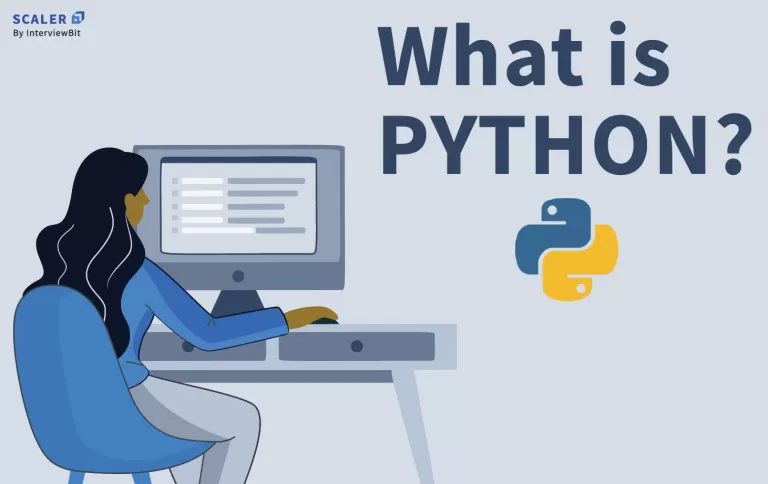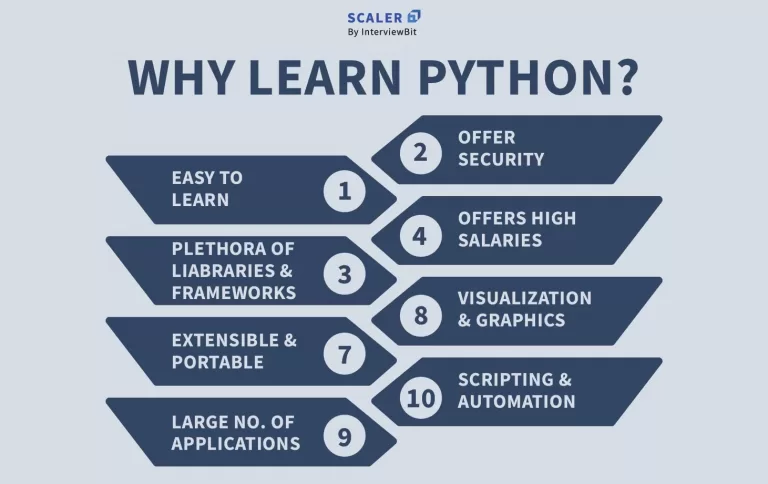What is Python?
Python is a high-level, object-oriented programming language developed by Guido van Rossum. This means that Python is based on data and is easily understood by humans.
Earlier, Python was only considered helpful for automating boring stuff, but its general-purpose nature soon came to light. We realised that Python differed from purpose-specific languages such as HTML/CSS, Ruby or PHP.

The introduction of Python as a general-purpose language revolutionised the world of programming. Python was no longer treated like other languages, i.e. used only to solve specific problems. It can be used in various domains such as Web Development, App Development, Data Science and Machine Learning.
Added to the versatility of Python, its simple syntax makes it the perfect fit for any newbie programmer.
Example:
Now that we have learned what is Python, let’s write a simple Python program to put our knowledge to use!
Take a look at this example of a Python program –
Problem Statement – Write a Python program to take two numbers from the user and print their sum.
Code:
- In the above code snippet, we took two numbers from the user using Python's “input” function and computed the sum.
- The sum was then displayed using the “print” function.
- We also added the relevant comment for the same.
What is Python used for?
Depending on how you plan to use Python, there can be several reasons it’s currently being used in the industry.
Some of the reasons are –
1. Python for Programmers:
The high level of abstraction offered by Python benefits all programmers. It’s highly interactive and has a simple syntax, making it everyone’s favourite.
2. Python for AI and Machine Learning
Because of its stable, flexible and straightforward nature, Python is widely employed in the realms of Machine Learning and Artificial Intelligence. It is one of the go-to languages for Data Scientists and Machine Learning practitioners because of the available AI and ML toolkits.
3. Data Analytics and Data Science
Much like AI and ML, Data Analytics and Data Science also use Python widely. At present, when we are creating more and more data every day, efficient platforms like Python are in huge demand for analysing, manipulating, and managing data.
4. Web Development and Game Development
Web Development and Game Development fields are not too far behind in the Python race. Python is highly efficient for developing quick game prototypes, offering most developers an edge. Web frameworks like Django and Flask make it challenging to say no to Python programming when it comes to tasks related to web development.
5. Highly compatible with all major platforms
Python supports all popular operating systems. The same codes can run on different platforms without recompilation.
6. Python for sysadmins
Those familiar with the art of shell scripting appreciate Python sincerely. Python ensures that automating tedious tasks is exciting and straightforward.
7. Python Community
Python has an enormous user community. This indicates that no matter what problem you will run into, you can find a solution with the support of the Python Community.
Why is Python so popular?

Let’s look at some key reasons –
1. Python is easy to learn
Yes! You read that right. The straightforward syntax of Python enhances its readability, making it one of the most accessible programming languages to grasp.
Many beginners often find programming intimidating, but Python serves as a friendly companion during the initial learning stages, offering a syntax that resembles English.
2. Python boasts a variety of libraries, frameworks, and packages.
Think of a programmable solution, look up relevant Python libraries, import them, and translate your solution into code by writing Python scripts. Surprisingly, the process is as straightforward as it sounds.
Python offers several popular and influential libraries, including NumPy and Pandas for Data Science; Matplotlib and Seaborn for Data Visualisation; Keras, PyTorch, etc., for Machine Learning and so much more!
3. Python and its applications.
Exploring python.org reveals a plethora of Python Success Stories spanning various industries such as recruiting, healthcare, financial services, marketing, and education, among others. The applications of Python appear boundless, making the current moment an opportune time to embrace the Python trend!
4. Python is a dynamically typed and extensible language.
Unlike traditional programming languages like Java and C, variables are not strictly declared before their values are assigned. This makes Python flexible and allows the variables to have a different data type at various times during the execution. This makes Python dynamically typed. We can use Python to modify or add syntax and code in other languages, making it an extensible language.
Python Syntax compared to other programming languages
- Python is Highly readable and straightforward, resembling English; fewer lines of code are needed, whereas other Languages have more complex syntax with additional boilerplate code.
- Python uses indentation to define code blocks, making whitespace significant, while other Languages use curly braces and are less strict about indentation.
- Python is dynamically typed,i.e., there is no need for explicit variable declaration, whereas other languages are statically typed, requiring explicit variable type declaration.
FAQ
Q. Is Python suitable for beginners?
A. Python is highly recommended for beginners due to its straightforward syntax, closely resembling English. This simplicity reduces the learning curve and helps novices understand programming concepts without getting bogged down by complex syntax. Moreover, the extensive support community and abundance of learning resources make it an ideal starting point for those new to coding.
Q. How much time is typically required to learn Python?
A. Acquiring a foundational understanding of Python can range from a few weeks to a few months, contingent on the specific aspects you aim to grasp and your learning frequency. Due to Python's versatility and the diverse tools available, delving into various language applications can extend your learning journey over several years. The duration of your Python learning experience is influenced by your objectives, such as the tasks you intend to accomplish and whether you aspire to apply Python professionally.
Q. Who uses Python today?
A. Python is used by many professionals, including software developers, data scientists, AI and machine learning engineers, network engineers, and more. Major companies like Google, Facebook, Instagram, Spotify, and Netflix use Python in various capacities.
Q. Is it advisable to acquire proficiency in Python 2 or Python 3?
A. Learn Python 3. Python 2 has reached its end of life and is no longer supported. Python 3 is the current and actively maintained version, with modern features and better performance.
Q. What types of jobs use Python?
A. Python is used in many job roles, such as:
- Web development
- Data analysis
- Artificial intelligence
- Scientific computing
- Cybersecurity
- Automation
Its versatility makes it a preferred language in many sectors, including finance, healthcare, marketing, and education.
Q. How does Python perform in machine learning and data science?
A. Python is a powerhouse in the machine learning and data science fields. Its strength lies in various specialised libraries, such as TensorFlow for machine learning, Pandas for data manipulation, and Matplotlib for data visualisation. These tools, combined with Python’s ease of use and community support, make it a top choice for professionals working with data, machine learning models, and statistical analysis.
Q. Is Python good for building mobile apps?
A. Python is not traditionally used for mobile app development, but it's possible with tools like Kivy, a Python library for developing multitouch applications. While it's more common to use languages like Swift for iOS and Kotlin for Android, Python offers a viable alternative for creating simple cross-platform mobile apps, especially for developers already comfortable with the language.
Q. How does Python integrate with other languages?
A. Python excels in working alongside other programming languages. It can seamlessly integrate with C/C++ for performance-critical tasks and Java for web applications. This interoperability is facilitated through various tools and libraries, allowing developers to harness the strengths of different languages in a single project, such as using Python for rapid prototyping and another language for performance optimisation.
Q. Can Python be used for game development?
A. Python can be used for game development, particularly for educational purposes or simple game prototypes. Libraries like Pygame provide the necessary tools for creating games. Still, it's important to note that Python is not the industry standard for high-performance game development, where C++ and specialised game engines like Unity are predominant. However, for beginners in game development or those looking to create simple, 2D games, Python is a good starting point.
Q. What is the future of Python in the tech industry?
A. Python's future in the tech industry looks very promising. Its role in critical and growing fields like artificial intelligence, machine learning, and data analytics ensures its relevance. Python’s adaptability, coupled with a strong community and continuous updates, positions it as a language that will continue to be in demand. Additionally, its use in educational settings further secures it as a foundational language for future programmers.
Conclusion
I am sure by now you have a clear idea about “What is Python?” and its advantages.
In this article, we also covered –
- Python Syntax
- Example of Python program
- Reasons to learn Python
- The advantages of Python
Start learning Python today and jet-set your journey to becoming a versatile developer!

